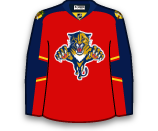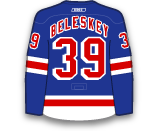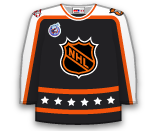Horvat, 19, has no points in five games with Utica during his conditioning assignment, but will draw into the lineup on Tuesday with Tom Sestito out indefinitely with a lower-body injury.

Horvat, 19, has no points in five games with Utica during his conditioning assignment, but will draw into the lineup on Tuesday with Tom Sestito out indefinitely with a lower-body injury.

Semin served as a healthy scratch in the last two games and surprisingly enough, the Canes recorded their first two victories of the year. With that being the case, Semin will likely have the shortest of leashes heading into tomorrow's clash with the Blue Jackets. We've seen a ton of players respond well to being a healthy scratch, lets see how Semin answers.

Colaiacovo skated alongside Luke Schnn in Flyers practice this morning. In addition to working on the third pair, Colaiacovo played the point on the Flyers' second power-play unit. He provides some offensive punch to Philly's blueline, but he is a huge injury risk and likely won't provide enough offence to be considered valuable in standard fantasy leagues.

Hertl is struggling out of the gate having posted just two goals and one assist in 12 games. Tonight Barclay Goodrow will move up and Hertl will skate on the fourth line. He should remain on your bench until his production comes back.

Manson, 23, was drafted in the sixth round (160th overall) in 2011. The 6-foot-3 blueliner had one assist in seven games with Norfolk before he was called-up. There is no word on who he will replace, but it should be Mark Fistric.

Semin skated as an extra in practice on Friday and with a couple healthy bodies coming back on Saturday, head coach Bill Peters is likely scratching Semin. The winger has just two assists in eight games and is a minus-5 over the last four games. He belongs on your bench until he turns things around.

Briere has two goals and one assist in 10 games this season. He played a season-low 6:31 on Tuesday and will be replaced by Dennis Everberg tonight vs. the Islanders.

Heatley made his Ducks debut on Tuesday and played just 13:26 with one shot on goal. In practice this morning he skated with Ryan Kesler and Devante-Smith Pelly while Matt Beleskey skated with Corey Perry and Ryan Getzlaf. It still is not a bad line, but his production would likely be higher on the top-line.

After just one game the Ducks have already moved Dany Heatley off of the top-line and replaced him with Beleskey. The big winger has five goals in the first 10 games of the season. He is averaging 2.7 shots per game and firing at 18.5% right now.

Hemsky jones Tyler Seguin, Jason Spezza, Jamie Benn and Trevor Daley on the Stars top PP unit for Friday's game vs. the Ducks. Hemsky is off to a painfully slow start to the season, having recorded just one assist with a minus-6 rating in the first nine games. The Stars are hoping the move to the top unit might spark some offence for the veteran winger.

Skinner was moved up to the top-line with Eric Staal and Alex Semin in Hurricanes practice this morning. The Canes don't play until Saturday, so we will see if this stays this way before their meeting with the Coyotes. They are still searching for their first win of the year, so no changes will hurt right now.

Wilson was originally listed as a game-time decision, but he will be in the lineup with Eric Fehr coming out of the lineup. He will start on the fourth line, but there was some chatter in the preseason that the Capitals were thinking about having him playing on the top line with Nicklas Backstrom and Alexander Ovechkin, so he might be someone to keep an eye on.

Jarnkrok has yet to record a point while piling up 11 shots and two PIMs in eight games this season. He will take a seat tonight with Gabriel Bourque and Matt Cullen entering the lineup. He has not been all that bad for the Predaotrs this season, but they want more offence from the 23-year-old.

Cullen will make his season debut tonight in Edmonton and he will start the game on the second line with Derek Roy and Craig Smith. Cullen had 10 goals and 29 assists (39 points) in 77 games a season ago. With Cullen in, Calle Jarnkrok will serve as a healthy scratch.

Saad, who has just one goal in the first nine games of the season, played just 15:08 on Tuesday and is skating on Chicago's fourth line with Marcus Kruger and Ben Smith this morning. It has been a rough start for the 22-year-old, who's value certainly takes a hit when he is not playing none of the Blackhawks premier players (Toews, Kane, Sharp, Hossa and Richards).

After Thursday's game vs. the Bruins, the Sabres will need to make the decision on whether or not to keep Reinhart with the team and burn the first year of his entry level contract or send him back to juniors. For Reinhart's development sake it is probably best for him to go back to juniors and with the Sabres playing as poorly as they are, that seems like a no brainer.

After a breakout season (20G / 31A) in 2013-14, Smith has just two goals and two assists through 11 games this season, despite playing slightly more and his shooting percentage (13.3%) remaining in-line with last season. The 23-year-old is a good scorer, but he will have to work his way back into the top-6 to be a consistent fantasy contributor.

In the first seven games of Green's season, he was averaging just 1:19 of power-play time per game, while John Carlson was seeing three minutes. At Capitals practice this morning, Green and Carlson swapped spots, which should have Green seeing the three minutes of PP time tonight vs. the Red Wings. Despite limited power-play time, Green has found a way to score three goals with five assists in seven games (one PPP).

Drouin owners got a preview of him on the first line with Steven Stamkos last week, but according to head coach Jon Cooper the plan all along was to ease him into the NHL, which is why he is currently on the third line. He played in the top-6 last week because of injuries up-and-down the lineup, but with healthy forwards returning, he will have to work his way back up.

Tinordi served as a healthy scratch on Monday vs. the Oilers but he will get back into the lineup tonight, presumably for Nathan Beaulieu, who replaced him last night.
